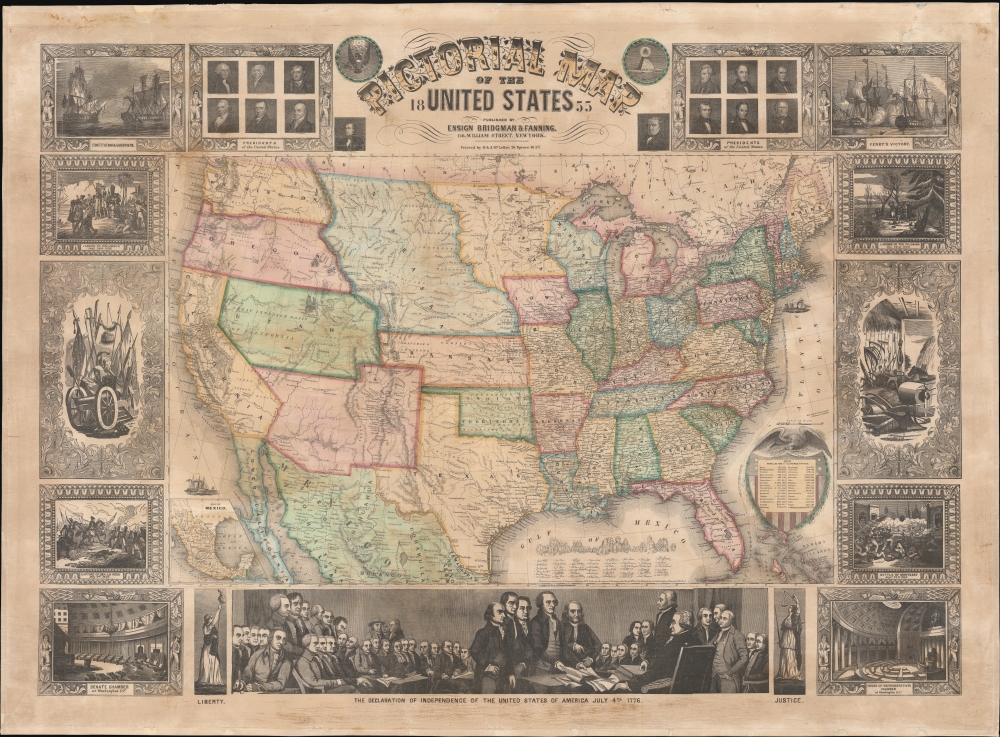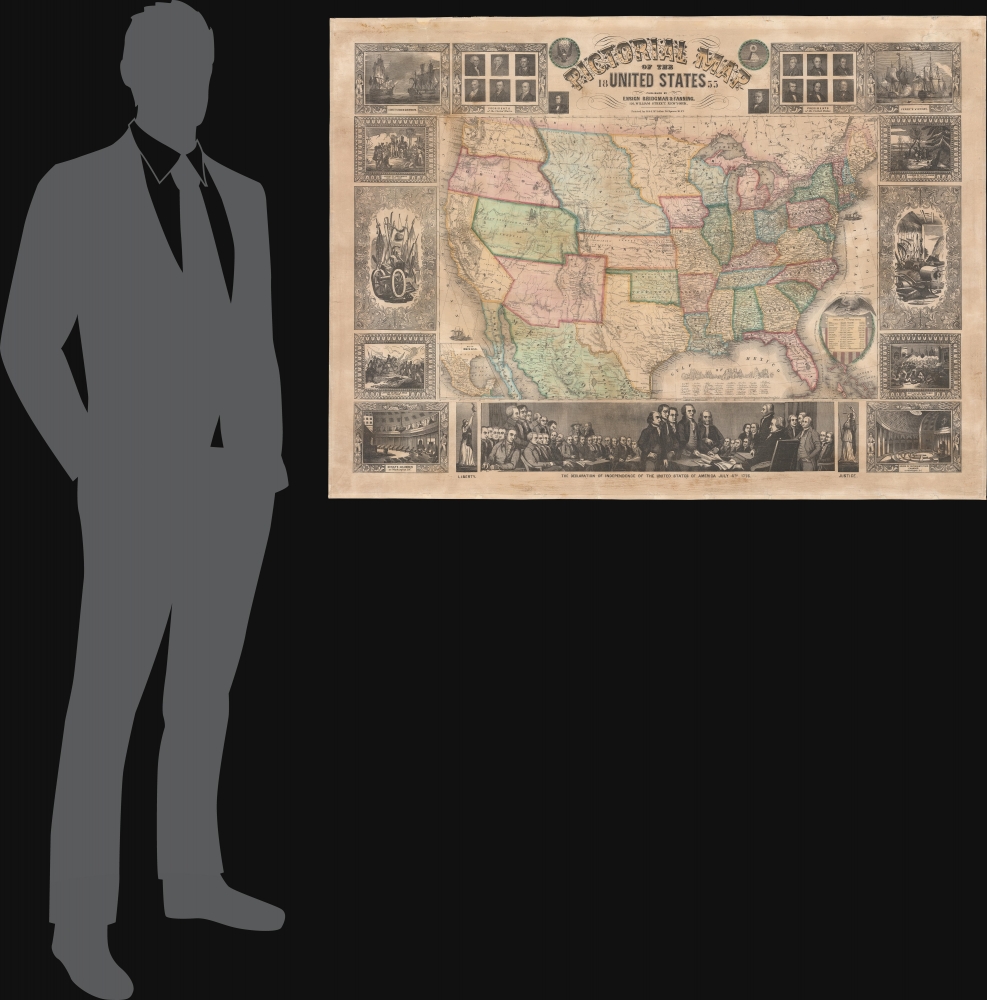1855 Ensign Bridgman and Fanning Wall Map of the United States
UnitedStates-ensignbridgemanfanning-1855
Title
1855 (dated) 31 x 43 in (78.74 x 109.22 cm) 1 : 6336000
Description
A Closer Look
The present example, representing the sixth edition, reveals major developments west following the 1849 Gold Rush and the general westward migration. California features significant development over earlier editions, with numerous new settlements, particularly around San Francisco Bay and Monterey. Further east, The Gold Region, along the the San Joaquin and Sacramento Rivers, is labeled. Great Salt Lake is presented in an embryonic form indicative of the generally poor knowledge of the Great Basin predating the Railroad Surveys being conducted as this map went to press. Salt Lake City itself is identified as 'City of the Great Salt Lake.' Other Mormon settlements along the east side of the lake are noted. Nebraska extends northwards to the Canadian border and both Washington and Oregon extend eastward to the Rocky Mountains. The apocryphal Louis Fork or southern extension of the Columbia River, named after Meriwether Lewis, is shown in southeastern Oregon. American Indian nations are identified throughout. A smaller map of Mexico appears on the lower leftRailroad Lines and Emigrant Trails
The rail lines at this time extended westward no further than Jefferson City, Missouri and Shreveport, Louisiana, west of which only wagon trails continued on to the Pacific. Many of these are noted including the 'Route to Oregon' (the famous Oregon Trail), the 'Route to Santa Fe,' and the southern route from 'Fort Smith to Santa Fe.' Other routes presented are the tracks of Fremont and the 'Great Spanish Trail from Los Angeles to Santa Fe.' Texas shows some development including an embryonic rail system running between Austin and the port of Galveston.A Decorative Map
True its descriptive title the map is surrounded by numerous pictorial vignettes illustrating, from the title clockwise: the Presidents of the United States, Perry's Opening of Japan, the Landing of the Pilgrims in 1620, farm tools, the 1846 Battle of Monterrey (Mexican American War), the United States House of Representatives Chamber, an illustration of Justice personified, the signing of the Declaration of Independence (largest illustration, bottom center), a personification of Liberty, the Senate Chamber, the capture of General La Vega 1846 (Mexican American War), weapons and armor, the landing of Columbus 1492, the Constitution and Guerriere (Navy Ships), and again, the Presidents.Publication History and Census
This map was published in 1855 by Ensign, Bridgeman, and Fanning, engraved by J. M. Atwood. Phelps and Ensign began issuing decorative wall maps of the United States in 1839 - which they advertised as Ensign's Travellers' Guide. That map used some of the same border and vignette art, but as a map terminated at the Mississippi. That map was dramatically expanded westward to account for the Texas Revolution (1836) in 1840. A further expansion ensued in 1847 under the imprint of Ensign, Thayer, and Phelps - the first of the lineage to extend to the Pacific. The map was fully re-engraved, rescaled, and retitled as a Pictorial Map of the United States, this being the third edition of that series. A second variant on this edition was issued by Ensign and Thayer in early 1848. Once the Mexican-American War ended in 1848, a larger run must have been issued, as the 1849 (Rumsey 5057) and 1850 editions appear more frequently. We are aware of another issued in 1852 (Rumsey 3508), then again in 1853, followed by editions by Ensign, Bridgman, and Fanning in 1854 and 1855 (Rumsey 265). A final edition, also by Ensign, Bridgman, and Fanning, appeared in 1858. All editions feature border work engraved by J. M. Atwood - although some are unsigned and the artworks is often in different configurations, suggesting that the border art pieces were separate plates. The maps surged in popularity after the war, reflecting increased interest in the American West fueled by both the Gold Rush and general expansionism.CartographerS
Edward Hooker Ensign (August 18, 1818 - July 10, 1871) was an American map and print publisher based in New York during the middle part of the 19th century. Edward was born in West Hartland, Connecticut. Little is known of Ensign's training but he may have inherited his business from his father, Timothy Ensign (1795 - 1859), who was a map publisher active in New York. Ensign seems to have had a flair for partnerships and variously published with Humphrey Phelps (1799 - 1875), Horace Thayer, Thomas C. Fanning (1805 - 1873) and Erastus C. Bridgman (1817 - 1870), among others. His various imprints include 'Phelps and Ensign' (1841-1844), 'T. and E. H. Ensign' (1844-1848), 'Ensign and Thayer' (1849), 'Ensign, Thayer, and Company' (1850-1851), 'Horace Thayer and Company' (1852), and 'Ensign, Bridgman and Fanning' (1854-1863). It appears that father and son worked together for some time as well, publishing as either 'T. and E. H. Ensign' or 'Ensigns'. At least some of these companies maintained offices in both Buffalo and New York City. More by this mapmaker...
Erastus Clark Bridgman (October 31, 1817 - August 25, 1870) was a New York City based map publisher active in the middle of the 19th century. Bridgman was born in Westhampton, Massachusetts. He was in South Carolina in 1849, where his first child was born, but moved to New York City by 1850. Bridgman was in partnership with Edward H. Ensign (1818 - 1871) and Horace Thayer from 1850 - 1852, publishing under the imprint of 'Ensign, Thayer, and Co.' Later, from 1854 - 1863, the partnership changed to Edward H. Ensign, Thomas C. Fanning (1805 - 1873), and Bridgman, publishing as 'Ensign, Bridgman and Fanning.' After his death, the Bridgman firm was taken over by his son Edward Clark Bridgman (1849 - 19??). Learn More...
Thomas Colt Fanning (August 2, 1805 - November 21, 1873) was a New York based map publisher active in the middle part of the 19th century. Fanning was born in Norwich, Connecticut. As a young man he apprenticed at a drugstore in Rochester, New York. When he reached his maturity, he relocated to Albion, New York, where he opened the town's first drugstore. He sold this business in 1849 to move to Brooklyn and enter the map publishing business. He initially partnered with Humphrey Phelps (1799 - 1875) and Thomas C. Fanning (1805 - 1873), joining the firm of 'Phelps and Fanning' as a junior partner. From 1854 to 1863 he partnered with Edward H. Ensign (1818 - 1871) and Erastus Clark Bridgman (1817 - 1870), publishing as 'Ensign, Bridgman and Fanning.' Learn More...
John M. Atwood (1817 - October 12, 1884) was an American engraver based in Philadelphia and New York City during the middle part of the 19th century. Atwood was born in Georgetown, near Washington D.C. Little is known of Atwood's life but most of his work was completed in conjunction with the publishing firms of Horace Thayer and J. H. Colton. A review of Atwood's work suggests that he was a highly accomplished, stylistically distinct, and detail oriented engraver. Colton seems to have turned to Atwood to engrave some of his most important as well as decorative maps. His most influential map is most likely the 1856 De Cordova pocket map of Texas, however, he also engraved the Colton's well known and highly decorative Thirty Three Miles Around New York and Colton's important 1849 Map of the United States. Learn More...




